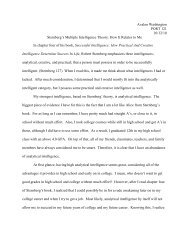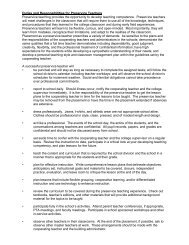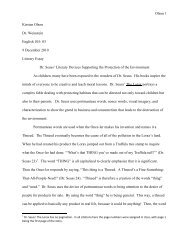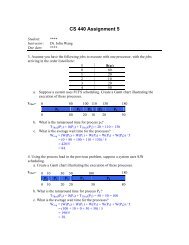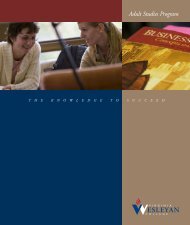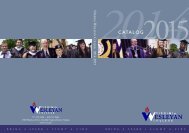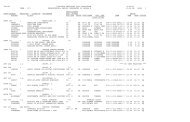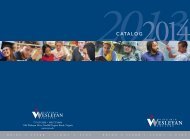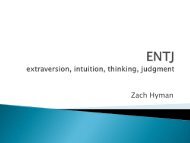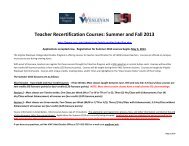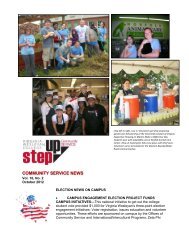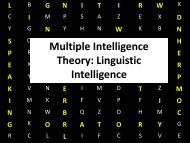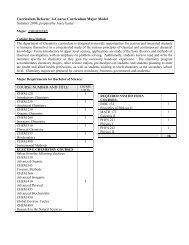2008-2009 Catalog - Virginia Wesleyan College
2008-2009 Catalog - Virginia Wesleyan College
2008-2009 Catalog - Virginia Wesleyan College
- No tags were found...
Create successful ePaper yourself
Turn your PDF publications into a flip-book with our unique Google optimized e-Paper software.
MATHEMATICS/COMPUTER SCIENCE131better), placement or consent. Must have a TI-83 or TI-84graphing calculator. Offered each semester.106 Statistics (3)Introduces students in the behavioral, social, andnatural sciences to the basic statistical tools required toanalyze experimental data. Topics include frequency distributions,graphing techniques, measures of central tendencyand dispersion, the normal distribution, point estimation,hypothesis testing and confidence intervals. Prerequisites:MATH 104 or MATH 105 (grade of C- or better),placement, or consent. Must have a TI-83 or TI-84graphing calculator. Offered each spring.125 Principles of Mathematics (3)Introductory treatment of the nature of mathematicalknowledge, history of mathematics, geometry, elementarynumber theory, and basic trigonometry. Prerequisite:placement (equivalent to the current MATH 135placement), MATH 104 or MATH 105 (grade of C- orbetter). Offered each semester.135 Calculus with Review I (3)Calculus is the mathematical language for changingquantities. It consists of computational and graphical toolsfor analyzing the relationships between such quantities.Students learn the basic tools of calculus, why they work,and how to apply them in various contexts. Symbolic,graphical and numerical approaches are considered. Topicsinclude limits, derivatives, and applications. There issufficient coverage of functions and trigonometry tosupport the study of calculus and of other sciences. Thetwo-course sequence, MATH 135 and 136, is sufficientpreparation for MATH 172 Calculus 2. Prerequisite:MATH 105 (grade of C- or better), placement or consent.136 Calculus with Review II (3)A continuation of MATH 135. Topics includeapplications of derivatives, the Riemann integral, and theFundamental Theorem of Calculus. There is sufficientinstruction in advanced algebraic techniques to support thestudy of calculus. Prerequisite: MATH 135 (grade of C- orbetter), placement or consent.171 Calculus I (3)Calculus is the mathematical language used to describechanging quantities. It consists of computational andgraphical tools for analyzing the relationships between suchquantities. In this course, we learn the basic tools ofcalculus, why they work, and how to apply them in variouscontexts. Calculus I develops the differential calculusthrough symbolic, graphical and numerical approaches.Topics include differentiation of algebraic andtranscendental functions, applications in modeling andoptimization, and the Fundamental Theorem of calculus.Graphing calculator required. Prerequisite: placement orconsent. Offered each fall.172 Calculus II (3)A continuation of Calculus I. More advancedtechniques are studied and used to solve quantitativeproblems in various contexts. Topics include integrationtechniques, applications of definite integration, differentialequations and sequences and series. Graphing calculatorrequired. Prerequisite: placement, MATH 136 or 171(grade of C- or better), or consent. Offered each spring.205 Discrete Mathematics (3)The analysis of finite step-by-step processes. It developsreasoning skills, enhances software-writing abilities andintroduces elementary computer circuitry. Topics includeBoolean algebra, digital logic circuits, the nature of validargument, mathematical induction, recursive sequences,and counting techniques, including combinatoricsmethods. Many class examples will be drawn fromcomputer science. Prerequisite: MATH 135 (grade of C- orbetter), MATH 171 placement or consent. Identical to CS205. Offered each spring. Recommended spring freshmanyear.217 Linear Algebra (3)The study of linear equations in several variables.Students develop the theoretical structure underlyinganswers to the questions: When does a solution for a systemof linear equations exist? When is it unique? How do wefind it? How can we interpret it geometrically? Topicsinclude vectors spaces, linear independence, bases,dimension, transformations, matrices, determinants, andapplications. Prerequisite: MATH 172 or consent. Offeredeach fall.226 Introduction to Statistical Modeling (3)An introductory course in applied data analysis.Emphasis will be on interpretation of statistical measuresand procedures. Statistical software is used extensively foranalyzing real data sets from various contexts. Topicsinclude measures of location, dispersion, correlation,parametric and nonparametric tests, simple and multipleregression, and ANOVA. Prerequisite: MATH 106, 136 orconsent. Offered each spring.300 Teaching Assistants’ Program for Math (1)Designed to allow qualified students to assist mathinstructors in the teaching of their classes. AlthoughMATH 300 will prove to be useful for those studentsseeking secondary education certification, enrollment is notopen solely to them. Enrollment is by invitation of theMATH/CS department. A student may enroll for MATH300 more than once, but may apply no more than a total ofthree semester hours earned in this manner towardgraduation. This course cannot be used to satisfymathematics major or minor requirements, although onesemester hour of MATH 300 is required for secondaryeducation certification. Prerequisite: consent. Offered eachsemester.



